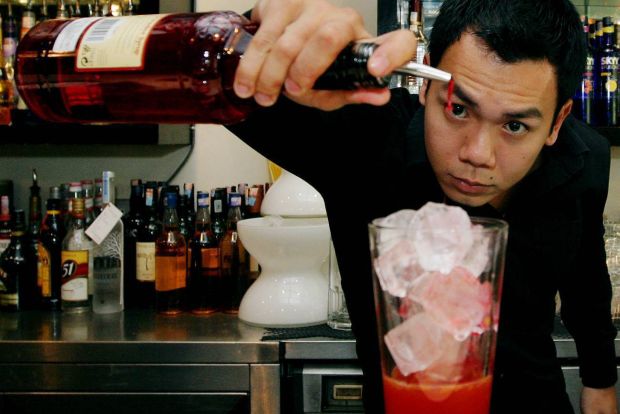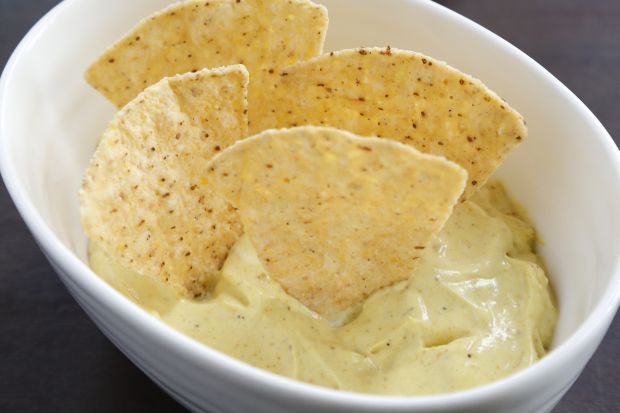Mixologists are taking drinks to new heights by integrating scientific principles with practical knowledge.
EVER wondered why James Bond takes his martini shaken and not stirred? For many, it may appear to be one of those diva-ish demands that movie characters make – like how Elle Woods of Legally Blonde prefers everything in pink, pink and pink.
But if you scratch beneath the surface, you’ll find that a martini, shaken, is different from a martini, stirred – or at least, so goes all the discussions that have surfaced since the phrase made its debut in an early 007 film.
Some of the leading authorities on this, apart from die-hard martini connoisseurs, are a special breed of nouveau bartenders, known as mixologists.
Not content with just turning the taps on, serving draws of beer or cocktails of yesteryear, these people are drawing knowledge from various fields – including science – and integrating it with practical aspects of bartending to create exciting new drinks for the world to sip.
One of them, Milan-born Lele Pauletto, who is currently based in ilLido Lounge Bar, Kuala Lumpur, says that martinis, contrary to Bond’s preference, taste better stirred. According to him, shaking makes the ice melt faster and while this is great for cocktails that need to be really cold, it also dilutes the taste.
Speaking of ice, Ben Ng, founder and director of Fluid Alchemy, a company specialising in providing drink solutions, says there is also some science involved, namely thermodynamics.
One of the things that affect the temperature and quality of a drink, is the shape of the ice, he says.
“The general rule of thumb is that the smaller the ice, the faster it melts.”
The surface contact also counts, he adds. A larger surface that is exposed to liquid accelerates the melting process. This means that an octagon-shaped ice, for example, will melt faster than a square one.
This explains why the quality of certain drinks may very well depend on the quantity and type of ice that is used in its preparation.
“In the case of gin-based drinks, cold temperatures actually reduce the spirit-y flavour,” explains Ng, adding that coldness also enhances the taste of drinks with berries and tropical fruits. “It brings out the freshness.”
Fresh out of high school 10 years ago, he started working at a bar in Penang while completing his hospitality management course. It was then, he confesses, that he decided to make a career out of bartending after trying it out for a couple of months.
“It was tough as I was working nights till 4am and then, I had to wake up early enough to attend my 9am classes,” he recalls. And he has never looked back since.
For the past three years, Ng no longer counts a bar as his workplace because he has moved on to drinks consultancy – providing branding, educational and training programmes to generate awareness and consumer engagement.
 Lele Pauletto of il Lido says that mixology courses are redundant if one does not have practical experience.
Lele Pauletto of il Lido says that mixology courses are redundant if one does not have practical experience.He calls himself a mixologist and his work involves developing “drink concepts” for major events. “There is the realisation, particularly among luxury companies, that drinks form an important component, driving a certain quality and exclusivity to their event,” he stresses.
“It can create hype, shape how an event turns out and even encourage people to stay longer.”
Did his degree in hospitality management help in any way?
“The most useful thing it has done for me is to prepare me for the administration and management parts. This puts me on a more professional level and enables me to gauge expectations,” he says.
However, Ng feels, the most pivotal thing any bartender or mixologist should have is practical experience and this can only be achieved through hard work and sweat. Lots of it.
“In the bartending industry, we start low. Right at the bottom.”
In his days, Ng was paid a basic salary of RM450 to work as a bar back. The basic is now RM800 to RM900. And though the title may officially be “bar backs”, they might as well be called peons.
A bar back is an assistant to all the bartenders. They are not allowed to prepare any drinks, and their tasks include preparing the bar, cleaning it, washing the toilets, carrying barrels of drinks, washing the glasses and replenishing the bar. In short, it’s a dirty job.
“A bar is just like a kitchen. You’ve got various stations and it’s the bar back’s job to ensure that the stations are in order,” Ng explains.
Usually, there will be a minimum number of two bar backs and when a new one comes in, the existing employees will place wagers on how long that person will last!
Similarly, ilLido’s Pauletto also believes in practical experience. Having gone through three courses – one in basic bartending and two in mixology – the 24-year old Italian stresses that these programmes would be redundant for someone who has not had hands-on experience.
To him, being a good mixologist involves getting to know all of your ingredients and products. “You have to know all your mixers, fruits and alcohol,” he says.
It’s similar to making a Screwdriver (cocktail), says Ng. A mixologist will have to think about which brand of vodka to use and which will give the drink a different character. This is because different vodkas have different tones due to the oils that are left over in the distillation process. Vodkas with a citrus flavouring may also work better.
Pauletto gives the example of an Absolut Cinnamon, which according to him, is “very strange to mix”.
“The strong flavour makes it impossible to drink on its own and it cannot go with anything sweet,” he says.
With this new spirit of mixology, are things changing in the Malaysian drinking scene?
“The bottle culture still predominates,” says Pauletto. Most people, at clubs or bars, still prefer to purchase an entire bottle of liquor than go for cocktails. He is hoping to change that mindset, however, by creating more awareness and introducing cocktails with local twists.
For instance, he loves using mangoes and mangosteens in his creations. The former, he says, has a very refreshing taste that goes well with many other fruits. “It’s not too sweet and I can throw in fruits like papayas and guavas, mix them with a bit of vodka and it’s good to go!”
Some mixologists are also experimenting with novel methods and ingredients. “Some of these are really weird,” muses Ng. An example is a leather-infused cocktail which he once heard of. Then, there are those who smoke their cocktails with Mesquite wood chips (typically used in barbeques)!
Pauletto himself has tried infusing tobacco leaves in his drinks. “I cut open a cigar and steep it in a spirit for five days at room temperature,” he explains.
Novelty can come at a very hefty price. Ng recalls the time when he prepared cocktails topped with (real) gold sheets. “It costs RM250 to RM300 for eight thin sheets about the size of a coaster and that fits about 200 drinks if you cut it really, really small!” he says.






